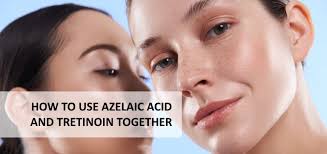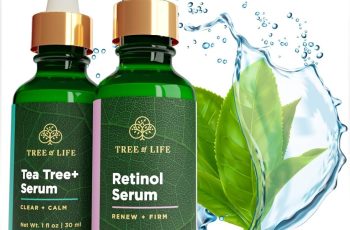
How to use Azelaic Acid with Tretinoin
The ingredients in today’s blog post are both well known within the beauty industry, for everyday people whoever, their names and benefits they deliver to the skin can still feel unknown, but not to worry, as this will be cleared up by the end of this blog post.
You’ll find that there are a vast variety of skincare products that contain both powerhouse ingredients, but the question is, how can you use azelaic acid with tretinoin. This is exactly what we’ll be demystifying in today’s blog post and with any luck, you’ll have a better understanding of how to team these under the radar skincare ingredients together and the results you’ll see on your skin.
Can you use tretinoin and azelaic acid?
Before I share with you the best way to use tretinoin and azelaic acid together, let’s first take a closer look into the benefits you can expect to see when using them.
What is Tretinoin?
Tretinoin is a medication also known as retinoic acid and often formulated into many skincare products used to help treat acne and sun-damage such as dark spots and hyperpigmentation. You’ll also find it is able to target deeper set wrinkles and improve the overall skin texture and tone. As potent as tretinoin is at targeting these skin concerns, with it comes something to bear in mind, that is having to introduce it slowly into your everyday skincare routine.
A common side effect of using any form of retinoic acid, also known as vitamin A, is an increase in flaky, dry patches of skin. This is perfectly normal for most skin types and is a result of your skin simply building its tolerance to the potency of tretinoin and its skin boosting benefits. If you are wanting to know more about tretinoin you can check out our dedicated blog post.
What is Azelaic Acid?
Often mistaken as a member of the large Alpha Hydroxy Acid (AHA) family, azelaic acid is a chemical exfoliant derived from grains, such as barley, wheat, and rye. It can work at sloughing the layer of dead skin cells and impurities that often lead to the complexion appearing dull, lack lustre and often showing signs of breakouts.
Suitable for almost all skin types especially when teamed with hydrating and nourishing skin ingredients, such as hyaluronic acid and niacinamide. Both provide impressive humectant properties meaning they can draw water into the skin and lock it into place keeping the protective skin barrier hydrated and plumped for the entire day. This will help combat any potential dryness caused when using azelaic acid in your daily skincare routine.
When teaming azelaic acid and tretinoin together an important factor you must take into consideration is using the correct combination and best percentages of each formula. For example, many scientific studies have shown the highest performing combination of 20% azelaic acid and 0.05% tretinoin cream will provide effective treatment for melasma and hyperpigmentation. With tretinoin helping to combat pigmentation to uneven skin tone and azelaic acid helping rid the skin of dead skin cells often which tends to make dark spots appear darker. Word of advice, stick to using this potent cocktail in your evening skincare routine as both ingredients increase the photosensitivity of the skin. Let tretinoin and azelaic acid overnight whilst you catch some beauty sleep and don’t forget to follow this with a high factor of sunscreen to protect the skin from UV exposure.
How do you use tretinoin and azelaic acid together?
I’ve mentioned this a few times over on The Beauty Insiders blog, but the product formulation each ingredient play an important role in how you use azelaic acid and tretinoin together. The general skin rule is applying your products from thinnest to thickest consistency, this will allow each product to absorb into the skin without having to compete with the physical barrier a thicker consistency would create. You’ll probably find that azelaic acid and tretinoin are formulated into similar products, most likely serums or other thicker products so allowing about 15 minutes in between applications will allow enough time for the product to fully absorb into the skin.
What goes first azelaic acid or retinol?
It is considered that applying azelaic acid after the type of retinol in are introducing into your routine, this will allow the skin to be prepared and ready for azelaic acid resulting in each product to absorb into the lower layers and get to work sloughing the build-up of dead skin cells, dirt, bacteria, and other impurities that often clog the pores leading to blackheads and other breakouts.
When should azelaic acid be used in routine?
To reap the rewards of azelaic acid in your routine, it is best to apply it to skin that has been fully cleansed, after a toner and gentle exfoliation. This will result in azelaic acid being able to penetrate the new layer of skin effectively and get to work targeting all manner of skin concerns.
Having said that, much like all skin types introducing a skin ingredient requires some time and dedication. Starting off with a consultation with a doctor or dermatologist to ensure it is safe for you to add the ingredient into your routine.
What can you not mix with azelaic acid?
When using azelaic acid it is recommended to avoid layering it with potent acids, such as the popular BHA, salicylic acid. This is because an increase in skin sensitivity and irritation which can not only cause a lot of discomfort but will prevent azelaic acid and any other skincare ingredient applied unable to deliver the best level of results.
Can you apply moisturiser after azelaic acid?
You can, in fact, it is considered overall a good idea as this will help calm and soothe the skin after the chemical exfoliation azelaic acid provides. Opting for a moisturiser that is enriched in a hydrating and nourishing ingredient, such as hyaluronic acid and niacinamide will keep the skin water and oil levels balanced and the protective barrier fully functioning allowing it to combat any signs of free radical damage.
I hope that today’s post has answered some questions you have had about using azelaic acid and tretinoin, don’t forget if you have any questions come and follow us on Instagram.


